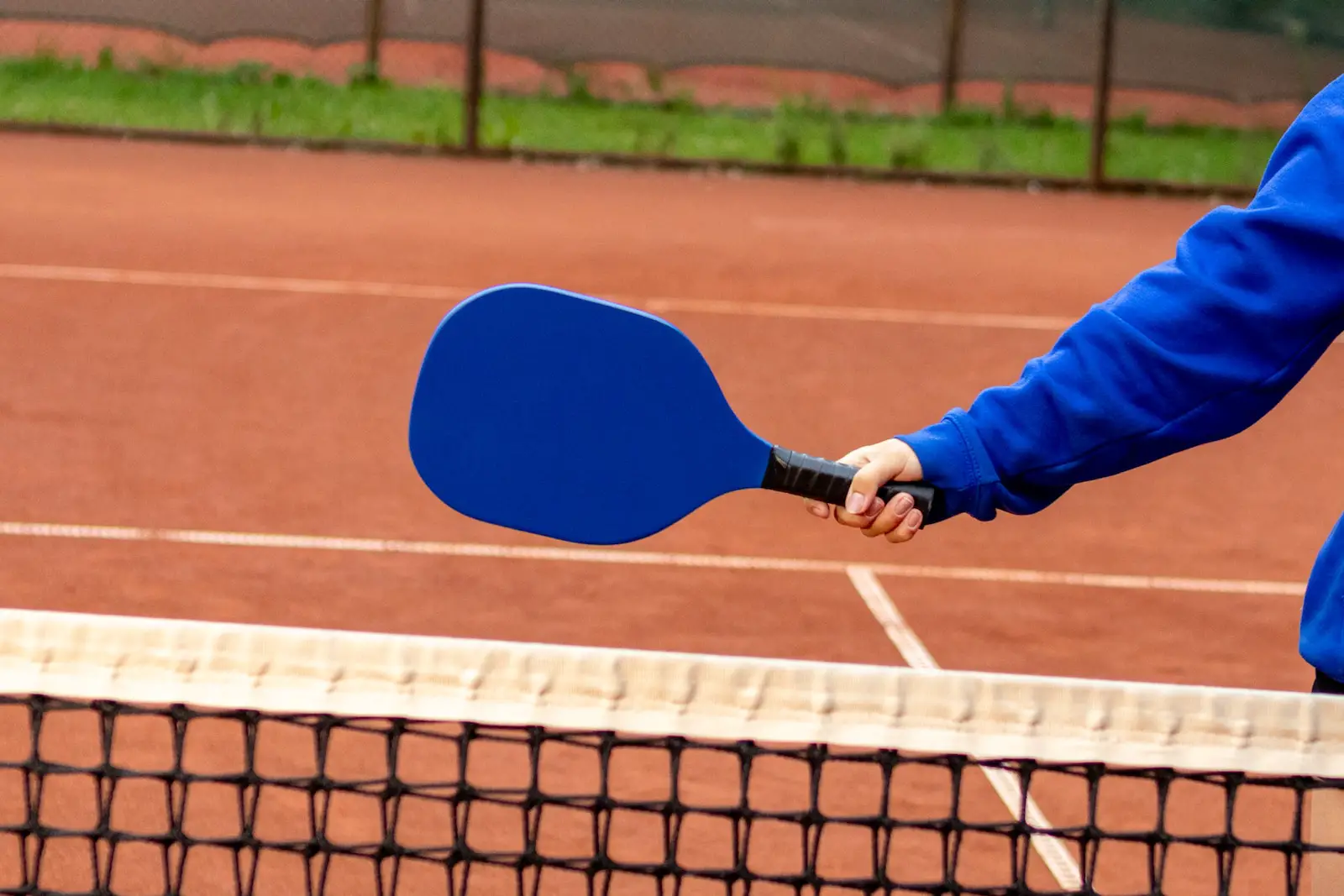Mastering the art of gripping a pickleball paddle can significantly up your game. It’s not just about holding the paddle; it’s about how you hold it. The right grip can provide better control, improve accuracy, and prevent injuries.
If you’re new to pickleball or even if you’ve been playing for a while, you may not realize the impact of your grip. It’s easy to overlook, but it’s a game-changer. Trust me, once you get the hang of it, you’ll notice a significant difference in your performance.
So, how do you grip a pickleball paddle correctly? Let’s dive into it. In this article, I’ll share some expert tips and techniques to help you master the perfect grip.
Why a proper grip is important in pickleball
So, why is a proper grip so important in pickleball? Let’s break it down.
- Control and Accuracy: When I grip the paddle correctly, I have complete control. It means I can direct the ball exactly where I want it to go. Sounds simple right? But it’s the small adjustments that make the biggest differences in your game.
- Power: A robust grip enables me to make powerful shots. When I hold the paddle correctly, I can use my wrist and forearm effectively, thereby generating a lot of power.
- Prevent Injuries: Lastly, and most importantly, a proper grip can prevent injuries. Believe me when I say that an incorrect grip puts undue stress on your wrist, elbow, and shoulder. Over time, this can lead to serious injuries.
Do not underestimate the importance of a proper grip. Even if you are an experienced player, you could be gripping your paddle incorrectly without even realizing it. It’s essential to regularly check and correct your grip. After all, the grip is literally where you ‘hold’ your game.
Here is a markdown table summarizing the benefits of a proper grip:
| Benefits of Proper Grip | |
|---|---|
| Control and Accuracy | ✔️ |
| Power | ✔️ |
| Prevent Injuries | ✔️ |
Join me as I delve deeper into various grip techniques in the following sections. Unearthing hidden tips, techniques, and secrets to master the perfect grip.
Basic anatomy of a pickleball paddle
Before diving into grip techniques, it’s crucial to understand the basic anatomy of a pickleball paddle. Many players might overlook this aspect, but I can’t stress enough how fundamental this knowledge is.
Pickleball paddles usually have three main parts: the handle, the throat, and the head. Each part plays a unique role in both the paddle’s performance and how you grip it.
The Handle
The handle is the part you hold. Its length, width, and weight greatly impact your swing and control over the paddle. In general, the handle’s length varies between 4 to 5.5 inches. The length you choose depends on your personal comfort and your playing style. A longer handle can provide more leverage for spins but may decrease the stability of your shot.
The Throat
The throat is the part connecting the handle and the head of the paddle. It’s not as straight as the handle, and it usually contains the paddle’s logo or brand name. The shape of the throat can influence the balance of the paddle and subsequently, your grip.
The Head
The head is the largest part of the paddle and it’s where you strike the ball. Most pickleball paddles have a large, broad head for a bigger hit surface. Similar to tennis rackets, pickleball paddles can have rectangular (classic style) or wide-body heads. The latter provides a larger hitting surface, which can be beneficial for beginners.
Getting to know the basic parts of a pickleball paddle will fundamentally enrich your understanding of the paddle’s dynamics. It will also aid in correcting your grip, improving your technique, and ultimately enhancing your game performance.
In the following section, we’ll discuss the different grip techniques that will help you master the perfect grip.
Remember, each player is different and what works for one player might not work for another. It’s about finding what works best for you.
Different types of grips in pickleball
So, we’ve discussed the importance of a proper grip in pickleball and dissected the anatomy of a pickleball paddle. I’m sure by now you’ve got a hang of the basics. But here’s where things get intriguing. There’s more than one way to grip a pickleball paddle. Yes, you read that right! Let’s delve into the world of various grip styles and how each affects your gameplay.
The Continental Grip
The first on our list is the Continental grip, also known as the “Hammer” grip. This one’s popular among pickleball players for its versatility and simplicity. It enables a seamless transition between forehand and backhand shots, making it great for a quick-paced game. I’ve found, however, that while it’s great for providing a balanced power and control, it might not offer the optimal power for some power shots or smashes.
The Eastern Grip
Next up is the Eastern grip, bearing some similarity to the Continental but with the hand rotated slightly clockwise. This clockwise tweak gives the player enhanced control over the paddle angle, thus enabling better topspin or under spin shots. It’s fairly easy to switch from a Continental to an Eastern grip, but mind you, it’s less effective for backhand shots.
The Western Grip
Taking things a notch deeper, we have the Western grip. This power-packed grip is all about aggressive play and sharp angles. It positions the paddle almost perpendicular to the ground, providing maximum power for drives and slams. While power shots are its forte, it’s not as flexible for different types of shots as the Continental or the Eastern grips are.
It’s pertinent to remember that no grip is inherently “better” than the others. They all have their role on the court and shine in different scenarios. To truly master pickleball, you’ll want to become comfortable with all three grips and know when to use each one strategically. The key to improving your grip isn’t necessarily to find the one perfect grip, but rather to adapt and adjust your grip depending on the situation at hand.
The continental grip
Transitioning to a more dedicated exploration of pickleball grips, the Continental grip comes to the forefront as one with noteworthy versatility. This grip is the jack-of-all-trades in the realm of pickleball. It’s equally effective for both forehand and backhand shots.
Holding the paddle using the Continental grip is much like shaking hands with someone. To acquire this grip, extend your hand as if you’re about to engage in a handshake. So as you hold the paddle, it should feel natural, comfortable. I often recommend this grip to beginners because it doesn’t involve as many finger position adjustments as other grips do.
An important factor to consider with the Continental grip is the paddle angle. During shots, the paddle remains perpendicular to the ground, which assists with topspin and under spin shots. This can increase the control you have over the ball and the direction it goes in.
In comparing it with the Eastern and Western grips, the Continental grip stands apart for its outstanding versatility. While the Eastern grip enhances control over paddle angle and the Western grip supports aggressive play, the Continental grip shines for its balanced application to varied play styles.
As a pickleball player, gaining proficiency with every grip style is of utmost importance. Being comfortable in switching between these grips based on the strategic needs of the game is a significant skill. So while the Continental grip provides a solid baseline grip, it’s not a one-size-fits-all. It’s critical to learn and practice the Eastern and Western grips as well.
The eastern forehand grip
The Eastern Forehand Grip is the second piece of the grip puzzle. We’ve discussed the versatility of the Continental grip, but the Eastern grip marks its territory when precision and control reigns supreme. Often, it’s referred to as the “shake hands” grip, its straightforward hold allows pickleball players to effectively target their shots and result in slicing through the opponents’ defense.
Unlike the Continental grip, the Eastern Forehand grip requires a player to have their base knuckle of the index finger and the heel of their hand on the third bevel of the paddle handle. This change in position facilitates an open paddle face which can enhance the depth and power of your strokes, particularly on the forehand side.
The Eastern grip is often my go-to choice for quick volleys around the net. When facilitated correctly, it can create a deadly combo of speed and placement. Yet, it may pose challenges with backhand shots due to the open face. Hence, it emphasizes the need for a quick transition to the Continental or Western grip for backhand shots, intensifying the grip flexibility and quickness in a game.
Given its attributes, the Eastern Forehand Grip tends to be highly favored by beginners due to its simplicity and comfort level. Still, it shouldn’t be underestimated by seasoned players. It offers unique advantages in certain strategic play situations. Nonetheless, the performance of Eastern grip largely depends on the player’s quickness in the game, and understanding when and where to use it effectively.
The western forehand grip
Aiming to refine your skills? We’re now shifting our focus from the Eastern Forehand Grip to the Western Forehand Grip in pickleball. This grip is another technique you need up your sleeve when the competition heats up.
It’s often joked that the Western grip is the ‘cowboy’ of pickleball grips. Why? Just imagine swinging a heavy frying pan – it’s that intuitive! It gives your shots an incredible topspin – the spin that keeps your opponents guessing and scrambling.
Positioning your hand requires a subtle turn so the knuckle of your index finger aligns with the bottom panel on the paddle handle. It might feel a bit awkward at first, but when you get the hang of it, you might feel like unleashing a whip against a line of tin cans. The Western grip is a touch tougher to master without practice, but can bring an unexpected twist to your shots.
Unlike the Eastern grip, the Western grip accommodates a powerful backhand. It provides an unbroken flow between the forehand and backhand, which comes with a unique strategic advantage. I’ve observed a satisfying ‘Thunk!’ when I connect with the ball on my backhand – showing a noticeable increase in power. By contrast, aiming and control might require more thought and adjustment.
Your decision to choose between the Western or Eastern grip often depends upon the scenario. You’re looking to secure a strategic advantage with power and topspin? The Western grip is your go-to option. But for those precision shots that require depth and subtlety, you might revert back to your Eastern grip.
The ability to transition and choose the right grip at the right moment truly puts you in the driver’s seat. So it’s not just about mastering the grip, but mastering when to leverage it!
Remember, a common trait among successful players is their adaptability. Balancing the strengths and limitations of each grip helps maximize your potential. So, let’s continue on this journey.
Tips for achieving a secure grip
Mastering the art of gripping your pickleball paddle is an essential step in succeeding at the game. I’ve shared the Eastern and Western grip styles and now I’ll share a few important tips that’ll help you achieve the perfect hold on any paddle.
Grip Lightly, Not Tightly
One common mistake many players make is gripping the pickleball paddle too tightly. Despite it seeming like a tighter grip would provide more control, it’s actually counterproductive. A lighter grip allows the wrist to move freely, enabling quick snap shots and giving you more speed and spin.
Adjust the Grip Size
Choose a pickleball paddle with a grip size that’s right for you. Just like tennis racquets, pickleball paddle grips come in different sizes ranging from 4 to 4 1/2 inches. The size directly corresponds to the measurement around the handle. Finding a paddle with a suited grip size for your hand can improve control and comfort, thus enhancing your overall game performance.
Maintain Paddle Orientation
When it comes to the pickleball paddle, its orientation is crucial for an effective shot. Keep the face of the paddle perpendicular to the ground as much as possible. This will create a larger and more forgiving hitting zone on the paddle, providing more consistency and control over your shots.
No matter the grip style you choose, remember that practice makes perfect. Spend time practicing different grips and shots and finding what works best for your game strategy. The perfect grip will not just improve your game but also keep yours hands and wrists safe from injury.
Common grip mistakes to avoid
It’s pivotal to dive into some common mistakes players often make while gripping their pickleball paddles. These are some pitfalls you should strive to bypass on your journey to becoming a pickleball savant.
One of the major blunders I’ve seen is gripping the paddle too tightly. This approach can hamper mobility, lessen the speed and spin of your shots, and possibly lead to injury. Maintaining a relaxed grip is absolutely essential for mastering quick snap shots and putting optimal spin on the ball.
Adjusting the grip size is an art that many players are mistaken about. A correctly sized grip can provide the perfect balance between control and comfort but choosing a grip that’s too big or too small can tip this balance. If your grip is too large, it’s harder to control the paddle, while a grip too small might strain your wrist and arm.
You’re probably wondering how to determine the right grip size. Well, here’s a handy trick: when you hold your paddle, there should be enough space for one finger to fit between the tips of your fingers and the base of your thumb.
Steering clear of these mistakes can significantly improve your pickleball experience, ensuring each match is not just a challenge, but also a pleasure.
Practice drills and exercises to improve your grip
Strength, comfort, and adaptability are key when it comes to mastering the pickleball paddle grip. If you’re looking to take your grip skills to the next level, I’ve got the ideal set of drills and exercises that’ll make all the difference.
Let’s dive right in.
The Squeaky Clean Drill
This drill helps you find just the right amount of tension required for an ideal pickleball grip. All you need is your pickleball paddle and a washing sponge. Hold the paddle as you normally would but between your paddle and your palm, insert a thin sponge. Now, just carry on playing! If you squeeze your paddle too hard, the sponge will squeeze out the water and you know the grip is too tight.
The Finger Stretches
This simple yet effective exercise can help improve your hand dexterity. All you’ve got to do is straighten your fingers and then tightly clench your fist. Repeat this stretch helping to increase your flexor strength and release tension from overly tight grips.
Up next, we’ve got a comprehensive drill.
The Tennis Ball Bounce
This drill can simultaneously increase your forearm strength and grip control. All you need is a tennis ball and your trusty pickleball paddle. Simply bounce the tennis ball off your paddle; keeping the ball under control is only possible with the correct grip and tension, giving you instant feedback on your grip success.
Embracing these practical drills and exercises will provide a significant boost to your grip game. It’s not just about the size of the grip or how tightly you’re holding it. It’s the consistent application of your grip in every playing scenario. You’ll notice how seamlessly the fundamental grip techniques translate onto advanced playing moves.
Conclusion
So there you have it – mastering the pickleball paddle grip isn’t just about strength or size. It’s about consistency and control. The Squeaky Clean Drill, Finger Stretches, and Tennis Ball Bounce drill are all valuable tools to enhance your grip skills. These exercises aren’t just for beginners, they’re beneficial for seasoned players too, helping to release tension and increase forearm strength. Remember, a well-rounded grip can make a world of difference in your pickleball game. Now that you’ve got the grip down, it’s time to move onto the next stage – serving techniques. Stay tuned for more pickleball prowess.














0 Comments